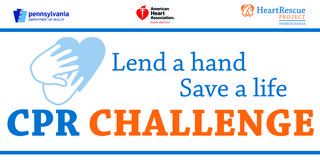Tocelebrate February as American Heart Month, the News Blog is highlighting someof the latest heart-centric news and stories from all areas of Penn Medicine.
 The PennsylvaniaHeartRescue Project, led by the Center for Resuscitation Sciencein Penn’s department of EmergencyMedicine, has partnered with the AmericanHeart Association and the Pennsylvania Bureau of Emergency Medical Services to form the “LendA Hand, Save a Life” CPR Challenge, which launched last month and will continuethrough late May. The initiative aims to train 250,000 people across theCommonwealth of Pennsylvania in cardiopulmonary resuscitation (CPR). The goal?To equip more people with the simple skill that is so essential to saving thelives of victims of cardiac arrest, which remains a leading killer across theUnited States. In most cities, survival rates still don’t exceed 10 percent,and those numbers haven’t budged in 30 years, despite advances in so many otherareas of cardiac care. Innovations like therapeutic hypothermia are helpingmove the needle and cut brain damage among cardiac arrest survivors, but thereal opportunity to save lives comes before patients even get to the hospital,in the crucial moments right after they arrest – at home, on the street, onsports fields or running trails, in office buildings. Getting CPR quickly candouble or even triple a person’s chance of surviving sudden cardiac arrest.
The PennsylvaniaHeartRescue Project, led by the Center for Resuscitation Sciencein Penn’s department of EmergencyMedicine, has partnered with the AmericanHeart Association and the Pennsylvania Bureau of Emergency Medical Services to form the “LendA Hand, Save a Life” CPR Challenge, which launched last month and will continuethrough late May. The initiative aims to train 250,000 people across theCommonwealth of Pennsylvania in cardiopulmonary resuscitation (CPR). The goal?To equip more people with the simple skill that is so essential to saving thelives of victims of cardiac arrest, which remains a leading killer across theUnited States. In most cities, survival rates still don’t exceed 10 percent,and those numbers haven’t budged in 30 years, despite advances in so many otherareas of cardiac care. Innovations like therapeutic hypothermia are helpingmove the needle and cut brain damage among cardiac arrest survivors, but thereal opportunity to save lives comes before patients even get to the hospital,in the crucial moments right after they arrest – at home, on the street, onsports fields or running trails, in office buildings. Getting CPR quickly candouble or even triple a person’s chance of surviving sudden cardiac arrest.
Although many people who’ve received CPR training in thepast may recall it as a complex series of chest compressions and rescue breathsthat need to be delivered in a specific ratio, research has shown thatbystander CPR delivered “hands-only” style – with no rescue breaths – is alsoan effective strategy in teenagers and adults, since blood remains oxygenatedenough to nourish cells in the brain and other parts of the body for severalminutes. Hands-only CPR simplifies the traditional process, by calling for justthree easy steps. First, call 911. Second, push hard and fast in the center ofthe victim’s chest (experts recommend humming or thinking of the Bee-Gees hit,“Stayin’ Alive,” which has the proper tempo – 100 beats per minute – to keepblood flowing adequately throughout the body). Third, send someone to find an automated externaldefibrillator (AED) and follow the instructions to shock the victim’s heartback into a normal rhythm.
“People can learn how to perform this lifesaving skill in lessthan twenty minutes,” says BenjaminAbella, MD, vice chair of research in the department of Emergency Medicineand clinical research director in the Center for Resuscitation Science. “Wewant to remove barriers to training and show members of the public that anyonecan save a life – cardiac arrest is a rare example of a medical emergency forwhich someone with no medical training can make a huge impact on a patient’schance of surviving.”
Inspiring local stories underscore the important role of laybystanders. Last winter, for instance, aSEPTA employee and a passenger jumped into action to save the life of a man whocollapsed while waiting for his train home at 30th Street Station.When the three were reunited at the Hospital of the University of Pennsylvaniajust days later, the man and his family called the rescuers their “angels” fortaking such swift action to help him.
At a kick-off event during the Pennsylvania Farm Show lastmonth, leaders of the Lend a Hand, Save a Life initiative trainedover 1,500 people. Moving forward, the organizers are offering resourcesfor schools, sports teams, community groups, and businesses to stagelarge-scale training events during, say, half-times of sporting events orduring intermissions at concerts. Last week, EMS providers demonstratedhands-only CPR for a crowd of more than 34,000 people at the Groundhog Daycelebrations in Punxsutawney, PA and more than 2,600 fans recently enjoyed ahalf-time demo at a Bucknell University basketball game in Lewisburg, PA. ThePenn HeartRescue Project team is planning an event in the Philadelphia area forthe spring. Prizes will be awarded to organizations that train the most people.